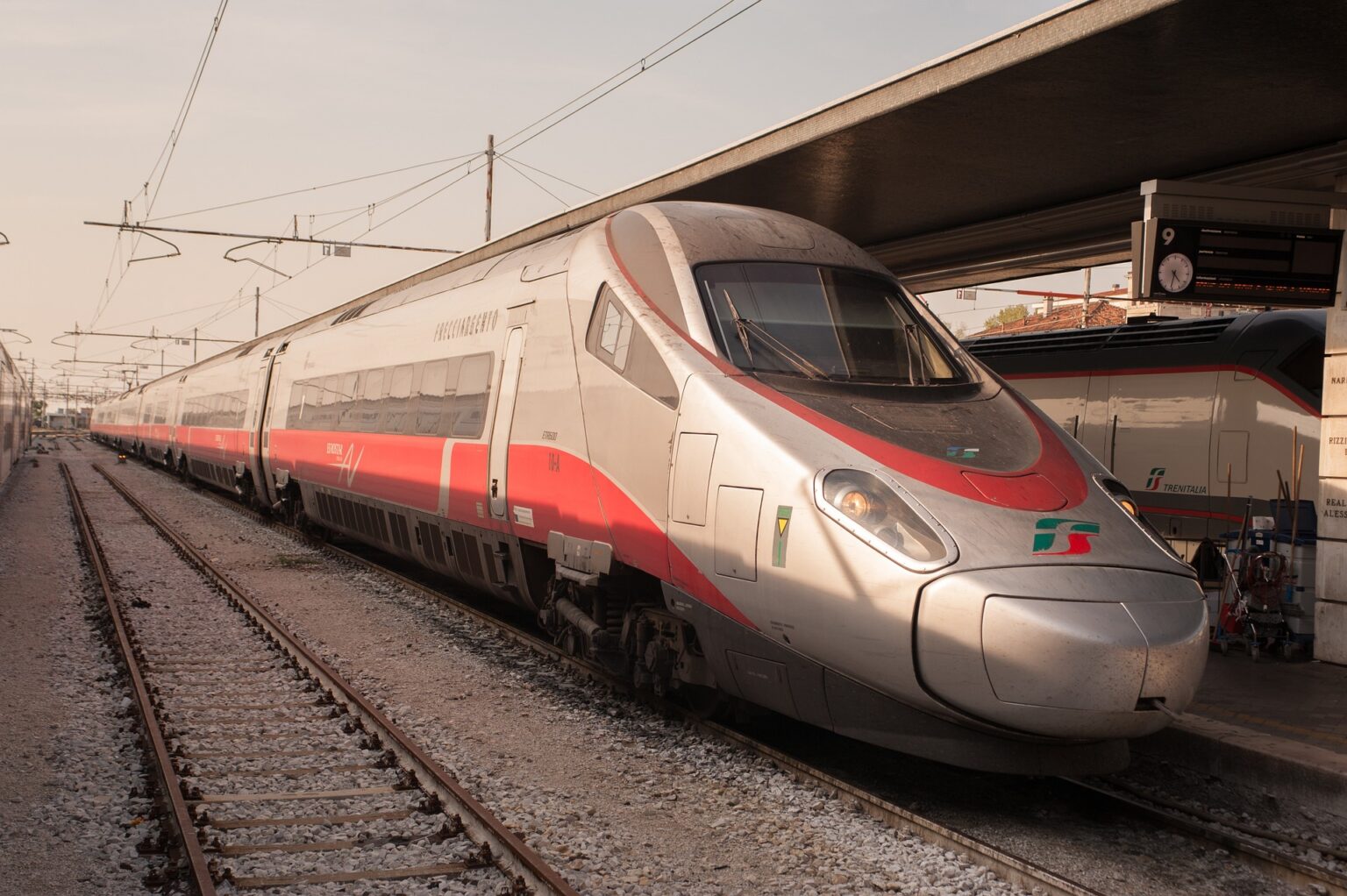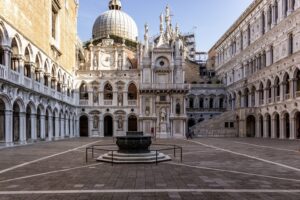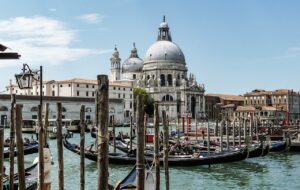🚄 Venice Santa Lucia Train Station: The Gateway to the Floating City
Venice Santa Lucia Railway Station is not just where trains arrive — it’s where Venice begins. The moment you step out of the marble hall and see the Grand Canal glittering in front of you, you understand why this is one of the most extraordinary railway stations in the world. It’s the only major train station in Europe that lets you step directly from platform to vaporetto, surrounded by domes, bridges, and gondolas instead of taxis and traffic.
🏗️ A Bridge Between Worlds: How It All Began
The story of Santa Lucia is a tale of vision and stubborn engineering. In the early 1800s, Venice was still a city reached only by boat. When Italian engineers proposed a railway connection across the lagoon, many Venetians protested, claiming that the vibrations of passing trains would destroy the delicate foundations of their city. But the world was changing, and Venice — then under Austrian control — couldn’t stay isolated forever.
After years of debate, in 1846, the Ferrovia Ferdinandea (now the Ponte della Libertà) was inaugurated, linking the mainland to Venice with a 3.6-kilometer causeway of 222 arches. It was named after Emperor Ferdinand I of Austria and quickly became a symbol of modern progress. Just imagine: after centuries of being reached only by ship, trains were suddenly gliding across the lagoon toward the floating city — a surreal sight for 19th-century travelers.
The first small terminal, completed around 1860, was functional rather than glamorous. It stood near the site of the ancient Church and Convent of Santa Lucia, which were demolished to make space for the new station. The relics of Saint Lucy were moved to the Church of San Geremia, where they remain today — a fascinating mix of faith and progress, typical of Venice’s layered history.
🇦🇹 Venice Under the Austro-Hungarian Empire
During the years of the Austro-Hungarian Empire, the station became a strategic hub. It was known as Venezia Tronchetto and marked the end of the Vienna–Venice railway line. The empire saw Venice as a jewel of its southern territories and wanted the station to reflect imperial prestige. By 1884, architect Adolph Cipolla redesigned it in the eclectic style fashionable in Central Europe — part Renaissance, part industrial modernity.
The new building included vast waiting rooms, a grand hall, a telegraph office, and a restaurant that served both local and Viennese dishes. Military officers in crisp uniforms rubbed shoulders with artists and aristocrats traveling to the Lido di Venezia for summer retreats. The railway not only brought soldiers and goods but also sparked a new cultural energy. Venice was no longer just a fading relic of the past — it was reconnected to the modern world.
Writers like Henry James and John Ruskin often commented on this strange juxtaposition: the hum of steam engines against the silence of the canals. Ruskin lamented the industrial intrusion; James, ever the romantic observer, noted that it “brought the world to Venice’s doorstep — for better or worse.”
🔥 Destruction and Rebirth: The 20th Century
When Italy regained control of Venice after World War I, plans began for a new, modern station worthy of a united nation. But the project dragged on through decades of political turmoil. Architect Angiolo Mazzoni, known for his work with Italy’s state railways, took the lead in the 1930s. His vision was bold: a long, low, rationalist structure that would complement rather than compete with Venice’s skyline.
Construction started in 1934, but World War II interrupted everything. Allied bombings heavily damaged the site, and for years after, only temporary shelters served passengers. Still, life pulsed through the ruins. Elder Venetians remember the sight of people in patched coats queuing for trains among broken glass and rubble, determined to rebuild.
Finally, in 1952, the new Stazione di Venezia Santa Lucia was inaugurated. Its clean horizontal lines, pale Istrian stone façade, and geometric mosaics reflected Italy’s postwar optimism. The architect’s signature touch — wide open spaces filled with natural light — created a sense of calm arrival, as if the city itself was exhaling after decades of tension.
Today, that same design remains almost unchanged. Look closely at the marble floors: their patterns echo the gentle waves of the lagoon. Even the clock above the entrance, simple and modernist, has become a silent symbol of countless reunions and goodbyes.
🚉 Life Inside Santa Lucia Today
Step inside today’s station, and you’ll find a blend of 1950s elegance and 21st-century practicality. There are cafés serving espresso and tramezzini, souvenir shops selling Venetian glass, and ticket counters where you can plan your next adventure. Digital boards hum above travelers rushing to their Frecciarossa platforms. Outside, gondoliers in striped shirts still wait — proof that in Venice, time moves differently.
Over 30 million passengers pass through Santa Lucia every year. It’s a true international crossroads — from students on Eurail trips to honeymooners heading to their first night in a canal-side hotel. Every morning, commuters from Mestre and Padua pour in, while long-distance trains glide toward Rome, Florence, and Milan. You’ll even find overnight routes to Vienna, Munich, and Paris.
🌍 Where Can You Go from Venice Santa Lucia?
From here, almost anywhere in Italy and much of Europe is within reach:
- Milan: Just 2 hours by high-speed train — ideal for a day of art and fashion.
- Florence: Roughly 2 hours and 15 minutes — a favorite among art lovers.
- Rome: Less than 4 hours away on the Frecciarossa.
- Naples: 5 hours to pizza perfection.
- Vienna or Munich: Overnight sleeper trains across the Alps — unforgettable views included.
- Paris: Take the night train for a cinematic journey from lagoon to lights.
If you’d like to make your arrival or departure smoother, our private transfers will get you from the station to your hotel, cruise terminal, or even the airport with zero stress — and in true Venetian style.
⚙️ How the Trains of Venice Work
Venice’s railway system connects directly to the Italian mainland via the Ponte della Libertà. The main lines are operated by Trenitalia and Italo, offering both regional and high-speed services. Regional trains run every 20–30 minutes to nearby cities like Padua, Vicenza, and Verona, while Frecciarossa and Frecciargento trains zoom across the country at up to 300 km/h.
For the most up-to-date schedules or to secure tickets, travelers can check online or use vending machines inside the station. Remember: validation is required for regional tickets before boarding!
🚂 The Italian Railway Story: From Steam to Super Speed
The first Italian railway line — the Naples–Portici line — opened in 1839 and ran for just 7.25 kilometers. But it sparked a revolution. Within decades, tracks crisscrossed the peninsula, linking major ports, factories, and towns. During unification, the railways helped knit the new country together, moving soldiers, goods, and ideas faster than ever before.
By the early 1900s, electric trains began to replace steam engines. Italy led Europe in railway innovation: in 1939, it launched the ETR 200, the world’s first streamlined electric train. It could reach 200 km/h — practically science fiction for the time. After the war, modernization continued, leading eventually to the Frecciarossa and Italo high-speed fleets we know today.
Today, Italy’s railway network stretches over 16,000 kilometers, linking mountain villages, coastal towns, and the great cultural capitals. For travelers, it’s one of the most scenic and comfortable ways to explore the country — especially when your journey begins in Venice, that eternal mix of water, stone, and wonder.
📖 Anecdotes and Hidden Details
- When the first train arrived in Venice in 1846, locals supposedly gathered along the lagoon banks to watch in disbelief — many feared the bridge would collapse under the locomotive’s weight!
- In the 1950s, film directors like Luchino Visconti and David Lean used Santa Lucia’s platforms in their movies. You can glimpse the station in Summertime (1955), when Katharine Hepburn’s character first steps into Venice — a cinematic echo of what travelers still feel today.
- The mosaic floors inside the station were designed to reflect the rippling effect of water, a subtle tribute to Venice’s aquatic soul.
- Behind platform 1 lies a small chapel built for railway workers — one of the few sacred spaces hidden inside an Italian train station.
💡 Local Tips for Travelers
Arriving early or waiting for your train? Step outside and take a short walk to the Scalzi Bridge for one of the best views of the Grand Canal. Or cross over to Fondamenta San Simeone Piccolo for a quieter café scene. The Off-the-Beaten-Path Orientation Tour starts nearby — the perfect way to explore hidden alleys right after you arrive.
If you’re leaving Venice, consider ending your journey with a peaceful sunset lagoon cruise or a glass of prosecco during our Cicchetti & Wine Tour — a farewell as unforgettable as the city itself.
🎯 In Conclusion
Venice Santa Lucia Railway Station stands as a symbol of connection — between past and future, land and sea, traveler and city. Every day, its echoing halls witness first arrivals, last goodbyes, and countless in-between moments that define the human experience of travel.
So when your train slows over the causeway and the skyline of domes and campanili appears, remember: this is not just the end of a line — it’s the beginning of your Venetian story.







